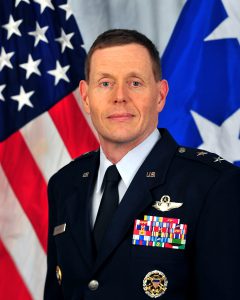Avascent First Person: National Security with Major General Robert E. Wheeler
 During the November episode of Avascent’s On the Record Podcast, Avascent research associate Hamilton Cook sat down with Major General Robert E. Wheeler (Air Force, Ret.) to discuss:
During the November episode of Avascent’s On the Record Podcast, Avascent research associate Hamilton Cook sat down with Major General Robert E. Wheeler (Air Force, Ret.) to discuss:
- How the national security environment is changing,
- How emerging near-peer threats will challenge the United States and industry, and
- How industry should prepare for a paradigm shift in how it presents new technologies and solutions to the government.
The interview also features a deep-dive into the difference between counter-insurgency operations and deterrence which leverages General Wheeler’s experience not only as a B-2 and B-52 combat pilot, but also his later experiences as the DoD Deputy Chief Information Officer (CIO) for C4.
Not enough time to listen in? Check out some of the highlights of the interview with General Wheeler:
What gets a bomber pilot interested in the ones and zeros of C4I networks?
If you think about the two aircraft I flew, both the B-52 and the B-2, the commonality of the two was the ability and the need to take in information so that you can accurately target.
Whether it is from a satellite, an unmanned aerial vehicle, a person on the ground, or an open source, the big data required to find a moving target or track pattern of life requires a lot of connections between C2 and ISR systems to bring it to the cockpit of an aircraft.
While everybody knows and loves the aircraft we use, it is really the networks that makes or breaks them. If the networking is not done correctly, you are going to have bad targeting, you are going to miss things, and Americans on the ground are not going to be protected. So it is a big deal, and it will make or break us in the next fight.
When we go into a not-permissive environment, it’s totally different situation. We have some amazing platforms with fifth-generation capabilities, but they are relying on second- or third-generation networks to connect them. That will cause us to lose the next fight, and that is why I care.
General Wheeler, in contrast to the last time the US faced a major near-peer threat in the Cold War, how do we see the various drastic advances in technology changing the threat environment? Which are the US going to have to focus on because they haven’t been prioritized in counterinsurgency operations?
I love that question because it really goes to deterrence. You are trying to find those disruptive technologies that negate the build-up of your near-peer adversary’s might. Our economy can’t spend tit-for-tat with both China and Russia all the time; it’s just not in our best interests.
But, with new technologies, we can find ways to defend against certain capabilities as well as disrupt those capabilities. The speed of technological change will accelerate the pace at which these disruptive technologies will reveal themselves.
The ability to accept these disruptive technologies – like the tank between World War I and World War II – and the ability to paradigm shift has been a strength of our nation, but the way that we are set up from an integrator perspective right now makes that harder.
However, we are starting to see movement on that, as the services start using Other Transactional Authorities. That’s’ a giant shift. That’s a shift to more risk. And it’s a shift that has been accepted by both Congress and the DoD to take advantage of this disruptive time.
When you look at how we view the idea of national security, General Wheeler, how is that going to be changing?
I think what you are seeing in the twenty-first century are two aspects:
First, the “What is national security?” question has shifted out of just the DoD realm to a larger question of economics. In the twenty-first century, economics is the focus for a lot of national security folks.
If you drop down to the DoD side, the big difference is that the twentieth century was all about the node. It was about the tank. It was about the aircraft carrier. It was about the airplane.
Twenty-first century warfare, especially with China, is about the network. It’s about the system of networks. That’s an issue in the US because there is no specific congressional district that focuses on networks.
Senior military folks still think about “How many tanks?” and “How many airplanes?,” but bringing them all together from a C4ISR perspective is the key.
Building off of the point you made about the centrality of economics to the question of, “What is national security?”, it’s interesting to see how much cyber operations interplay with economics:
It’s been said in multiple studies that we lose at least a percentage of Gross Domestic Product (GDP) a year to intellectual property theft, and the number one country doing that is China. And it’s a cultural issue.
It’s something that we look at very differently than they do. And we struggle to actually understand it. So many of their airplanes look like ours.
Many of their ships have many of the characteristics that we have. It’s because a lot of intellectual property, at levels people have no idea even exist, has been stolen, and China has built their economy on the backs of American industry.
When we look at China in particular, in what ways are they going to challenge us as a near-peer?
China is more nationalistic than we have seen in the past. It’s not regional for them anymore; it’s worldwide. We are seeing their ambitions move farther and farther out.
So, we are going to have to be very careful economically, and we are going to have to be very careful militarily over the next few years.
We don’t have the confidence-building measures that we do with the Russians. We don’t understand each other’s cultures really well. There is a lot more risk when dealing them.
As we move into this era of the near-peer, what do you see General Wheeler as the hardest lessons for the Pentagon and industry to learn or perhaps un-learn?
The need to switch how you think to understand deterrence and understand the perspective of preventing war, and then being able to conduct war if prevention doesn’t occur.
It’s a totally different dynamic. It takes years to understand. Many of our officers, particularly mid-grade, are phenomenally good at counterinsurgency, but none have had depth in strategic deterrence. That’s a change.
Industry is no different. Industry has been providing incredible capabilities for counterinsurgency for the last 15 years.
If I walk through a list of technologies, like electromagnetic pulse hardening or certain electronics, that industry no longer has, it’s because it was different threat, and they will need to bring that back. That’s tough.
Frankly, industry looks sometimes to the Department of Defense to say, “Okay. This is what I want.” The problem is that the DoD is still learning what it needs.
I would think of both groups as a team, and I don’t think that the Department of Defense right now is well organized to put out the RFIs and RFPs that feed the kind of tools we need for a non-permissive environment.
We have gotten used to, as a DoD and an industry, waiting for that RFI or RFP to drop.
It’s time for industry to come forward and market to DoD, because DoD doesn’t know what it wants, and they don’t even have the time to understand what’s out there. Technology isn’t changing like it was in the ‘80s or ‘90s. It’s changing faster.
The DoD doesn’t understand what’s available, whether it is from Silicon Valley or the big integrators, because they physically cannot keep up with it along with their other duties.
So, it is incumbent upon industry, in my opinion, to make the investment and push hard at the senior level on what’s out there, what are the capabilities, and on a path forward to build those capabilities.
Want to hear more? Listen to the whole interview with Maj. General Wheeler here.
This interview snippet has been edited for clarity and grammar.



